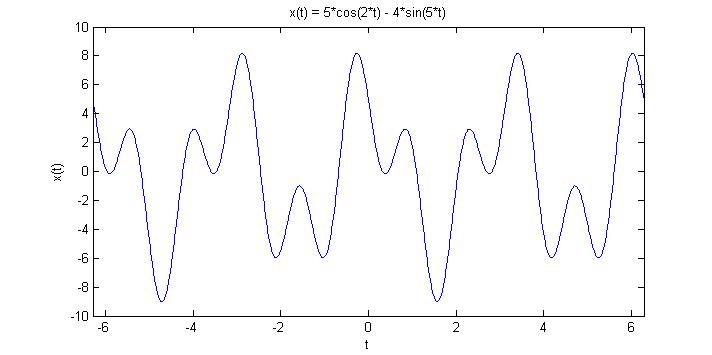(→Periodic CT Signal and Its Fourier Coefficients) |
|||
| (4 intermediate revisions by 2 users not shown) | |||
| Line 1: | Line 1: | ||
| + | [[Category:problem solving]] | ||
| + | [[Category:ECE301]] | ||
| + | [[Category:ECE]] | ||
| + | [[Category:Fourier series]] | ||
| + | [[Category:signals and systems]] | ||
| + | == Example of Computation of Fourier series of a CT SIGNAL == | ||
| + | A [[Signals_and_systems_practice_problems_list|practice problem on "Signals and Systems"]] | ||
| + | ---- | ||
== Periodic CT Signal and Its Fourier Coefficients == | == Periodic CT Signal and Its Fourier Coefficients == | ||
A Fourier Series of a periodic CT signal is such that:<br> | A Fourier Series of a periodic CT signal is such that:<br> | ||
| − | <math> x(t) = \sum_{n=-\infty}^\infty a_k * e | + | <math> x(t) = \sum_{n=-\infty}^\infty a_k * e^{j*k*w_0*t}</math> |
where | where | ||
| Line 8: | Line 16: | ||
<math> a_k = \frac{1}{T} \int_{0}^{T} x(t)* e</math><sup>(<math>-j*k*w_0*t</math>)</sup><math> \,\ dt</math> | <math> a_k = \frac{1}{T} \int_{0}^{T} x(t)* e</math><sup>(<math>-j*k*w_0*t</math>)</sup><math> \,\ dt</math> | ||
| + | If our signal <math> x(t) </math> consists of only sine and cosine waves, we don't have to do all those complicated integrals in order to find the Fourier coefficients <math> a_k </math>. | ||
| Line 23: | Line 32: | ||
Therefore, | Therefore, | ||
| − | <math> x(t) = 5 * \frac{1}{2} * (e</math><sup>(j2t)</sup> <math> \,\ + e</math><sup>(-j2t)</sup><math> \,\ ) - 4 * \frac{1}{ | + | <math> x(t) = 5 * \frac{1}{2} * (e</math><sup>(j2t)</sup> <math> \,\ + e</math><sup>(-j2t)</sup><math> \,\ ) - 4 * \frac{1}{2j} * (e</math><sup>(j5t)</sup> <math> \,\ - e</math><sup>(-j5t)</sup><math> \,\ )</math> |
| − | <math> \,\ x(t) = \frac{5}{2} * e</math><sup>(j2t)</sup> <math> \,\ + \frac{5}{2} * e</math><sup>(-j2t)</sup><math> - \frac{4}{ | + | <math> \,\ x(t) = \frac{5}{2} * e</math><sup>(j2t)</sup> <math> \,\ + \frac{5}{2} * e</math><sup>(-j2t)</sup><math> - \frac{4}{2j} * e</math><sup>(j5t)</sup> <math>+ \frac{4}{2j} * e</math><sup>(-j5t)</sup> |
The period <math> \,\ T = 2\pi </math> so if <math> \,\ w_0 = \frac{2\pi}{T} </math>, then <math> \,\ w_0 = 1 </math>. | The period <math> \,\ T = 2\pi </math> so if <math> \,\ w_0 = \frac{2\pi}{T} </math>, then <math> \,\ w_0 = 1 </math>. | ||
| + | |||
| + | Our new equation can now be rewritten as:<br> | ||
| + | |||
| + | |||
| + | <math> \,\ x(t) = \frac{5}{2} * e</math><sup>(<math>j*w_0*k_1*t</math>)</sup> <math> \,\ + \frac{5}{2} * e</math><sup>(<math>j*w_0*k_2*t</math>)</sup><math> - \frac{4}{2j} * e</math><sup>(<math>j*w_0*k_3*t</math>)</sup> <math>+ \frac{4}{2j} * e</math><sup>(<math>j*w_0*k_4*t</math>)</sup> | ||
| + | <br><br> | ||
| + | where <math>k_1,k_2,k_3,</math> and <math> k_4</math> correspond to { <math> \frac{5}{2}, \frac{5}{2} , -2 , \frac{2}{j}</math> }, respectively. | ||
| + | |||
| + | |||
| + | Therefore, we can take the coefficients of the equation and the <math> k </math> values to determine the Fourier coefficients. | ||
| + | |||
| + | <math>\mathbf{a_2} = \mathbf{\frac{5}{2}}</math><br><br> | ||
| + | <math>\mathbf{a}</math><sub>-2</sub><math> = \mathbf{\frac{5}{2j}}</math><br><Br> | ||
| + | <math>\mathbf{a_5} = \mathbf{-2}</math><br><br> | ||
| + | <math>\mathbf{a}</math><sub>-5</sub><math> = \mathbf{\frac{2}{j}}</math><br><br> | ||
| + | |||
| + | <math> a_x = 0 </math> elsewhere. | ||
| + | ---- | ||
| + | [[Signals_and_systems_practice_problems_list|Back to Practice Problems on Signals and Systems]] | ||
Latest revision as of 09:58, 16 September 2013
Example of Computation of Fourier series of a CT SIGNAL
A practice problem on "Signals and Systems"
Periodic CT Signal and Its Fourier Coefficients
A Fourier Series of a periodic CT signal is such that:
$ x(t) = \sum_{n=-\infty}^\infty a_k * e^{j*k*w_0*t} $
where
$ a_k = \frac{1}{T} \int_{0}^{T} x(t)* e $($ -j*k*w_0*t $)$ \,\ dt $
If our signal $ x(t) $ consists of only sine and cosine waves, we don't have to do all those complicated integrals in order to find the Fourier coefficients $ a_k $.
Take the signal $ x(t) = 5cos(2t) - 4sin(5t) $. The graph below proves that it is indeed periodic, with a period $ T = 2\pi $.
$ \,\ sin(x) = \frac{1}{2j} * (e $(jx) $ \,\ - e $(-jx)$ \,\ ) $
and
$ \,\ cos(x) = \frac{1}{2} * (e $(jx) $ \,\ + e $(-jx)$ \,\ ) $
Therefore,
$ x(t) = 5 * \frac{1}{2} * (e $(j2t) $ \,\ + e $(-j2t)$ \,\ ) - 4 * \frac{1}{2j} * (e $(j5t) $ \,\ - e $(-j5t)$ \,\ ) $
$ \,\ x(t) = \frac{5}{2} * e $(j2t) $ \,\ + \frac{5}{2} * e $(-j2t)$ - \frac{4}{2j} * e $(j5t) $ + \frac{4}{2j} * e $(-j5t)
The period $ \,\ T = 2\pi $ so if $ \,\ w_0 = \frac{2\pi}{T} $, then $ \,\ w_0 = 1 $.
Our new equation can now be rewritten as:
$ \,\ x(t) = \frac{5}{2} * e $($ j*w_0*k_1*t $) $ \,\ + \frac{5}{2} * e $($ j*w_0*k_2*t $)$ - \frac{4}{2j} * e $($ j*w_0*k_3*t $) $ + \frac{4}{2j} * e $($ j*w_0*k_4*t $)
where $ k_1,k_2,k_3, $ and $ k_4 $ correspond to { $ \frac{5}{2}, \frac{5}{2} , -2 , \frac{2}{j} $ }, respectively.
Therefore, we can take the coefficients of the equation and the $ k $ values to determine the Fourier coefficients.
$ \mathbf{a_2} = \mathbf{\frac{5}{2}} $
$ \mathbf{a} $-2$ = \mathbf{\frac{5}{2j}} $
$ \mathbf{a_5} = \mathbf{-2} $
$ \mathbf{a} $-5$ = \mathbf{\frac{2}{j}} $
$ a_x = 0 $ elsewhere.


